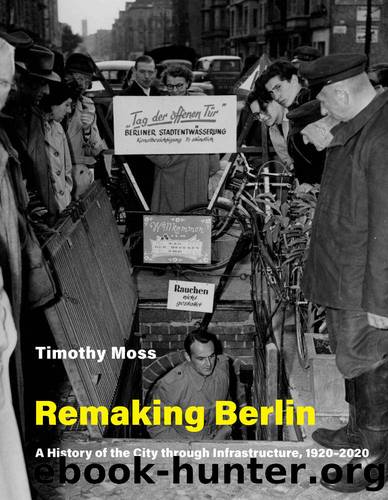Remaking Berlin (Infrastructures) by Timothy Moss

Author:Timothy Moss
Language: eng
Format: azw3
Tags: sociotechnical history, Vulnerability, National Socialism, urban planning, Energy, Socialist ideal, networked infrastructure, sociotechnical systems, water, urban history, Berlin, twenty-first century, urban infrastructure, Weimar Republic, Greater Berlin, West Berlin, municipal politics, twentieth century, socioeconomic change, energy policy
ISBN: 9780262539777
Publisher: MIT Press
Published: 2020-09-29T05:00:00+00:00
Serving the âBetterâ Berlin
Following the political division of Berlin in 1948â1949, the Eastern sector of the city possessed a number of strategic advantages over its Western counterpart. First and foremost was its continued function as a national capital. Legally, East Berlin was not part of the DDR, but one of the four sectors of a Greater Berlin still operating under occupied rule. Representatives of East Berlin had only advisory status in the East German Peopleâs Assembly (Volkskammer); East German laws needed approval by the city council (Magistrat) to be valid in East Berlin.5 In practice, however, the Soviets permitted East Berlin to become the capital of the DDR, in violation of the Potsdam Agreement of 1945. By retaining capital status for at least the Eastern part of Berlin, they reinforced their claim that the DDR represented the âtrueâ Germany and that West Berlin was a postwar construct merely tolerated within the DDR.6 Throughout the period of division East Berlin was presented, by Soviet and East German authorities alike, as a showcase for socialism in Germany.7 It housed national ministries and party organizations, retained access to its hinterland, witnessed ambitious urban projects, and was always privileged in the territorial distribution of resources. As a result, East Berlin was not noticeably poorer than West Berlin during the early 1950s.8
Political posturing of this kind was substantiated by the head start East Berlin had over its rival in terms of infrastructure capacity and connectivity. In 1950 the largest power station and principal groundwater resources were located in the Eastern sector of the city. Whereas West Berlin that year had only 267 MW of electricity-generating capacity at its disposal to serve 2.15 million inhabitants, East Berlin could boast nearly double the capacityâ499 MWâto supply just 1.19 million inhabitants.9 Without having to supply parts of West Berlin, the East Berlin utility was able to provide much-needed electricity to the national (DDR) grid in the winter of 1952â1953.10 Emboldened by such surplus resources, East Berlinâs infrastructure managers flaunted their advantageous position as an expression of the superiority of socialist means of production (see figure 7.1). Its water utility could boast household consumption rates of 250 liters per person and day in the new apartments along the Stalinallee.11 The district heating network installed there was heralded as a model for cleaner, modern heating systems across the DDR.12 The political agenda underpinning infrastructural achievements was made explicit in the contribution by the cityâs electricity utility, Bewag (East), to the DDRâs second five-year-plan in October 1956. The document opened with the statement: âIn planning Berlinâs energy supply priority must be given to the role of Berlin as the capital of a reunified Germany and the need to supply the whole city with electricity in the most efficient and advanced manner. West Berlinâs pursuit of bridgehead politics with regard to its electricity supply results in high energy bills for the West Berlin population without guaranteeing full security of supply. This must be replaced by the rational alternative of connection to the [DDR] grid.
Download
This site does not store any files on its server. We only index and link to content provided by other sites. Please contact the content providers to delete copyright contents if any and email us, we'll remove relevant links or contents immediately.
Aircraft Design of WWII: A Sketchbook by Lockheed Aircraft Corporation(31773)
The Great Music City by Andrea Baker(21313)
Call Me by Your Name by André Aciman(18965)
The Art of Boudoir Photography: How to Create Stunning Photographs of Women by Christa Meola(17841)
Shoot Sexy by Ryan Armbrust(17142)
Plagued by Fire by Paul Hendrickson(16637)
The Secret History by Donna Tartt(16624)
Portrait Mastery in Black & White: Learn the Signature Style of a Legendary Photographer by Tim Kelly(16484)
Adobe Camera Raw For Digital Photographers Only by Rob Sheppard(16387)
Photographically Speaking: A Deeper Look at Creating Stronger Images (Eva Spring's Library) by David duChemin(16161)
Bombshells: Glamour Girls of a Lifetime by Sullivan Steve(13109)
Pimp by Iceberg Slim(12931)
Ready Player One by Cline Ernest(12839)
The Goal (Off-Campus #4) by Elle Kennedy(12433)
Art Nude Photography Explained: How to Photograph and Understand Great Art Nude Images by Simon Walden(12348)
Kathy Andrews Collection by Kathy Andrews(10520)
Thirteen Reasons Why by Jay Asher(7788)
Wonder by R.J. Palacio(7732)
Goodbye, Things by Fumio Sasaki(7728)
